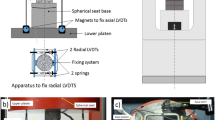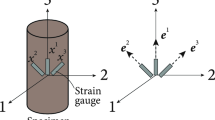Abstract
When carrying out uniaxial, standard triaxial, or true triaxial compressive tests on rock, the strain response of the specimens can be measured directly or indirectly. The most commonly used devices are strain gauges (local direct measurements) and displacement sensors (global indirect measurements). Strain gauges are glued to specimens and directly measure electrical resistance. Displacement sensors, typically linear variable differential transformers (LVDTs), indirectly measure displacements. The former is more precise at its smaller measurement scale, but may not work under high temperatures or when a strain gauge detaches due cracking under stresses close to the peak or in the post-peak portion of the stress–strain curve. It was observed that the strain responses recorded using strain gauges and displacement sensors tend to differ, which is why a corrective approach was proposed to recover stress–strain curves based on indirect measurements. This study describes an approach to correct platen-to-platen displacement measurements based on energy calculations to derive axial strain and to obtain radial strain using modified computations based on the volume fluid change within the Hoek’s cell in triaxial testing. The study concludes that part of the displacement recorded by LVDTs can be associated with displacement in the plate sample contacts, but the component of energy transmitted to the samples can be estimated at different levels of load, so that these indirect measurements can be corrected. For the case of triaxial tests, the volumetric or radial strain can be computed based on the volume change in the Hoek’s cell. This approach is useful for correcting indirect strain measurements. It can also serve as a starting point for the development of corrections for application to data from other test types, such as for true triaxial tests. The study aims to ultimately contribute to a better understanding of strain measurements while conducting compressive tests on rock.




















Similar content being viewed by others
References
Acar C, Gunduz Z, Kara B (2014) Modulus of elasticity determination of rocks using compressometer, strain gauge and LVDT. In: 11th International Congress on advances in civil engineering- ACE 2014
Alejano LR, Arzúa J, Bozorgzadeh N, Harrison JP (2017) Triaxial strength and deformability of intact and increasingly jointed granite samples. Int J Rock Mech Min Sci 95:87–103
Alejano LR, Arzúa J, Castro-Filgueira U, Kiuru R (2018) Scale effect of intact Olkiluoto gneissic rocks through uniaxial compressive testing and geophysical measurements. Posiva Oy Report 2018–13. Finland. http://www.posiva.fi/en/databank. Accessed 30 Mar 2020
Arzúa J, Alejano LR (2013) Dilation in granite during servo-controlled triaxial strength tests. Int J Rock Mech Min Sci 61:43–56
Arzúa J, Alejano LR, Walton G (2014) Strength and dilation of jointed granite specimens in servo-controlled triaxial tests. Int J Rock Mech Min Sci 69:93–104
ASTM (2004). D 2845–00 (reapproved 2004). Standard Test Method for Laboratory Determination of Pulse Velocities and Ultrasonic Elastic Constants of Rock. ASTM International, West Conshohocken, USA
Bastola S, Cai M (2020) Investigation of mechanical properties of jointed granite under compression using lattice-spring-based synthetic rock mass modeling approach. Int J Rock Mech Min Sci. 126:104191
Behrestaghi M, Sehizadeh M, Young R (2018) ONKALO POSE experiment—integrated analyses of true-triaxial tests. Posiva Oy Report 2018–14, Finland. http://www.posiva.fi/en/databank. Accessed 25 Mar 2020
Behrestaghi Nasseri MH, Young RP, Suikkanen J (2016) ONKALO POSE experiment—strength, deformation and seismic response of Olkiluoto isotropic pegmatitic granite and anisotropic migmatitic gneiss under a state of true-triaxial stress. Posiva Oy Rep. 2016–41. Finland. http://www.posiva.fi/en/databank. Accessed 25 Mar 2020
Bieniawski ZT, Bernede MJ (1979) Suggested methods for determining the uniaxial compressive strength and deformability of rock materials. Int J Rock Mech Min Sci Geomech Abstr 16:138–140 (Also in ISRM (2007))
Brady BHG, Brown ET (2004) Rock mechanics for underground mining, 3rd edn. Springer Science and Business Media, Dordrecht
Castro-Filgueira U, Alejano LR, Mas Ivars D (2020) Particle flow code simulation of intact and fissured granitic rock samples. J Rock Mech Geotech Eng 12:960–974
Crouch SL (1970) Experimental determination of volumetric strains in failed rock. Int J Rock Mech Min Sci 7(6):589–603
Diederichs MS, Martin CD (2010) Measurement of spalling parameters from laboratory testing. In: Rock mechanics and environmental engineering. Paper presented at Proceedings of Eurock 2010; pp: 323–326. Lausanne, Switzerland.
Eberhardt E, Stead D, Stimpson B, Read RS (1998) Identifying crack initiation and propagation thresholds in brittle rock. Can Geotech J 35:222–233
Eloranta P, Siren T (2015) Uniaxial Compressive Strength Test Results of ONKALO Borehole ONK-PP68. Working Report 2015–29. Posiva Oy. Helsinki, Finland. http://www.posiva.fi/en/databank. Accessed 20 Mar 2020
Fairhurst CE, Hudson JA (1999) Draft ISRM suggested method for the complete stress–strain curve for intact rock in uniaxial compression. Int J Rock Mech Min Sci Geom Abstr 36:281–289 (Also in ISRM (2007))
Farmer IW (1983) Engineering behavior of rocks, 2nd edn. Chapman&Hall, London
Fogged NN, Andreassen KA (2016) Strength and deformation properties of volcanic rocks in Iceland. In: Proceedings of the 17th Nordic Geotechnical Meeting: challenges in Nordic Geotechnic 25th–28th of May.
Ghabraie B, Ren G, Zhang X, Smith J (2015) Physical modeling of subsidence from sequential extraction of partially overlapping longwall panels and study of substrata movement characteristics. Int J of Coal Geol 140:71–83
Ghazvinian E, Diederichs MS, Archibald J (2011) Challenges related to standardized detection of crack initiation thresholds for lower-bound or ultra-long-term strength prediction of rock. In: Proc. of 2011 Pan-Am CGS Geotechnical Conference, Toronto, Canada
Hakala M, Heikkilä E (1997a) Laboratory testing of Olkiluoto mica gneiss in borehole OL-KR10. Posiva Oy Working Report 97–07e. Finland. http://www.posiva.fi/en/databank. Accessed 20 Mar 2020
Hakala M, Heikkilä E (1997b) Development of laboratory tests and the stress–strain behavior of Olkiluoto mica gneiss. Posiva Working Report 97–04. Finland. http://www.posiva.fi/en/databank. Accessed 20 Mar 2020
ISRM (2007) Suggested methods for determining the uniaxial compressive strength and deformability of rock materials. In: ‘The complete ISRM suggested methods for rock characterization, testing and monitoring: 1974−2006’. Prepared by the commission on testing methods, ISRM. Ankara, Turkey: Ulusay R, Hudson JA eds.; 2007.
ISRM (2015) Upgraded ISRM suggested method for determining sound velocity by ultrasonic pulse transmission technique. In: A. Aydin. In ‘The ISRM Suggested Methods for Rock Characterization, Testing and Monitoring:2007–2014’. Prepared by the commission on testing methods, ISRM. Springer: Ulusay R, ed; 2015.
Jacobsson L (2007) Forsmark site investigation Borehole KFM01C Uniaxial compression test of intact rock. SKB report P06–89. Stockholm, Sweeden.
Jacobsson L, Sandström J, Flansbjer M, Sjögren T, Brander L (2016) ONKALO POSE experiment—laboratory determination of density, porosity and mechanical anisotropy of gneiss and granite. Posiva Oy Working Report 2016–31. Finland. http://www.posiva.fi/en/databank. Accessed 20 Mar 2020
Korinets A, Alehossein H (2002) On the initial non-linearity of compressive stress–strain curves for intact rock. Rock Mech Rock Eng 35:319–328
L’homme TP, De Pater CJ, Helfferich PH (2002) Experimental Study of Hydraulic Fracture Initiation in Colton Sandstone. In: Proceedings of the SPE/ISRM Rock Mechanics in Petroleum Engineering Conference, pp. 266–277.
Małkowski P, Ostrowski Ł, Brodny J (2018) Analysis of Young’s modulus for Carboniferous sedimentary rocks and its relationship with uniaxial compressive strength using different methods of modulus determination. J Sustain Min 17:145–157
Martin CD (1993) The Strength of massive Lac du Bonnet Granite around underground openings. Ph.D. Dissertation. University of Manitoba
Martin CD, Chandler NA (1994) The progressive fracture of Lac du Bonnet granite. Int J Rock Mech Min Sci Geomech Abstr 31:643–659
Medhurst TP (1996) Estimation of the in-situ strength and deformability of coal for engineering design. Ph.D. Thesis. University of Queensland, Australia
Munoz H, Taheri A, Chanda EK (2016) Pre-peak and post-peak rock strain characteristics during uniaxial compression by 3D digital image correlation. Rock Mech Rock Eng 49:2541–2554
Muñoz-Ibáñez A, Delgado-Martín J, Juncosa-Rivera R, Romera-Rodríguez L, Alejano LR, Canal-Vila J, González-Molano N, Alvarellos J, López-Puiggene E, Lakshmikantha MR (2019) Development of a true triaxial device for hydraulic fracturing experiments. ISRM 2019. In: 14th International Congress on rock mechanics and rock engineering. Foz de Iguacu, Brasil. Pages: 1195–1202. CRC Press.
Nicksiar M, Martin CD (2012) Evaluation of methods for determining crack initiation in compression tests on low-porosity rocks. Rock Mech Rock Eng 45:607–617
Nicksiar M, Martin CD (2013) Crack initiation stress in low-porosity crystalline and sedimentary rocks. Eng Geol 154:64–76
Price AM, Farmer IW (1981) The Hvorslev surface in rock deformation. Int J Rock Mech Min Sci 18:229–234
Quiñones J, Arzúa J, Alejano LR, García-Bastante F, Mas Ivars D, Walton G (2017) Analysis of size effects on the geomechanical parameters of intact granite samples under unconfined conditions. Acta Geotech 12:1229–1242
Sharma H, Mishra S, Rao KS, Gupta NK (2018) Effect of cover depth on deformation in tunnel lining when subjected to impact load. In: ISRM International Symposium—10th Asian Rock Mechanics Symposium, ARMS 2018.
Shirole D, Walton G, Hedayat A (2020) Experimental investigation of multi-scale strain-field heterogeneity in rocks. Int J Rock Mech Min Sci 127:104212
Sinha S, Walton G (2020) A study on Bonded Block Model (BBM) complexity for simulation of laboratory-scale stress–strain behavior in granitic rocks. Comput Geotech 118:103363
Sinha S, Walton G, Kim BH (2020) Difficulties in determining the Crack Initiation (CI) thresholds for three different rock types. In: Proceedings of the 2020 American Rock Mechanics Symposium
SKB (2006) Method description for uniaxial compression test for intact rock. http://www.skb.com/publications/. Accessed 17 Mar 2020
Taheri A, Tani K (2008) Use of down-hole triaxial apparatus to estimate the mechanical properties of heterogeneous mudstone. Int J Rock Mech Min Sci 45:1390–1402
Valli J, Hakala M (2016) ONKALO POSE experiment—analysis of rock mechanics test data. Posiva OY Working Report 2016-49. October 2016
Walton G, Arzúa J, Alejano LR, Diederichs MS (2015) A laboratory-testing-based study on the strength, deformability, and dilatancy of carbonate rocks at low confinement. Rock Mech and Rock Eng 48:941–958
Walton G, Alejano LR, Arzúa J, Markley T (2018) Crack damage parameters and dilatancy of artificially jointed granite samples under triaxial compression. Rock Mech & Rock Eng 51:1637–1656
Young RP, Nasseri MHB, Sehizadeh M (2020) Mechanical and seismic anisotropy of rocks from the ONKALO underground rock characterization facility. Int J Rock Mech Min Sci 126:104190
Acknowledgements
This work has been financed by REPSOL S.A. The first author thanks the Commission for Cultural, Educational, Scientific Exchange between the USA and Spain of the Fulbright Program for financing a Scholar Visit to Colorado School of Mines, where part of this study was completed. The second author acknowledge the Spanish Ministry of Universities for funding of his work in the project, awarded under Contract Reference No. RTI2018-093563-B-I00, partially financed by means of ERDF funds from the EU.
Author information
Authors and Affiliations
Corresponding author
Additional information
Publisher's Note
Springer Nature remains neutral with regard to jurisdictional claims in published maps and institutional affiliations.
Rights and permissions
About this article
Cite this article
Alejano, L.R., Estévez-Ventosa, X., González-Fernández, M.A. et al. A Method to Correct Indirect Strain Measurements in Laboratory Uniaxial and Triaxial Compressive Strength Tests. Rock Mech Rock Eng 54, 2643–2670 (2021). https://doi.org/10.1007/s00603-021-02392-4
Received:
Accepted:
Published:
Issue Date:
DOI: https://doi.org/10.1007/s00603-021-02392-4




